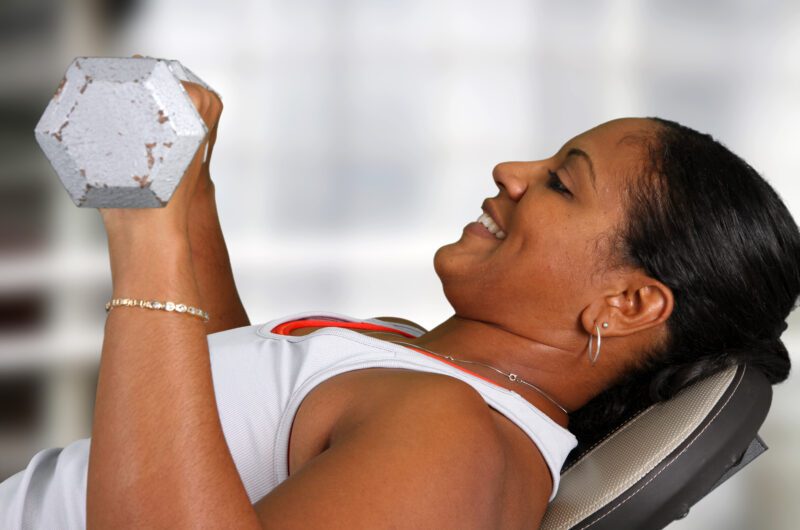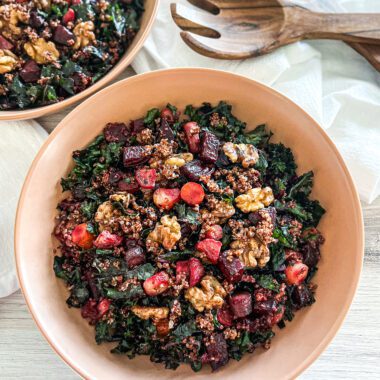Here at That Salad Lady, we’re all about whole food nutrition for whole life wellness – but we believe exercise and other forms of physical activity are just as important as good nutrition for overall good health. This is actually one of the Guiding Principles upon which I founded That Salad Lady. Our bodies were made to move, not to sit. When we move our bodies the way they’re meant to move we feel more energized, happy and self-confident.
While there are certain key principles of exercise, movement itself could be anything from taking a daily lunchtime walk to using the stairs instead of the elevator to parking farther from your destination and getting in more steps.
However, in addition to the simple act of moving, it’s also important that we push ourselves a little from time to time in order to use our bodies at their full potential. This is the difference between exercising and just moving – and it’s a relative concept. Exercising could mean a brisk 3-mile walk for one person and a 6-mile run for someone else. It doesn’t have to be overly complicated though.
As an exercise physiologist my advice is pretty straightforward, “move” throughout the day and “exercise” throughout the week. To help you better understand what I mean when it comes to the exercise element, here I’ll highlight seven simple principles of exercise you can apply, whether you’re a weekend walker, a seasoned athlete or just starting from scratch.
1. Progression
When it comes to exercising, the notion of progression is related to how intensely you work out. You can naturally boost the intensity of any type of exercise by going at it harder or longer. For instance, walking at a 4 mile per hour (mph) pace for 30 minutes is a lot more “intense” than a 30-minute walk at a leisure pace of 3 mph. But, if you’re unable to walk that fast, you can increase the intensity of a leisure walk by upping the duration (time) to 60 minutes.
2. Regularity
I can’t stress enough the importance of exercising regularly. Our bodies perceive sporadic exercise as a physical threat, which causes our stress hormone levels to surge. The more you exercise, the less of a threat it poses to the body. So, exercise often. Shoot for 3-5 days of cardiovascular exercises like brisk walking, jogging, bicycling and group exercise along with 2-3 days of resistance training using free-weights, machines, tubing or even your own body weight.
3. Overload
Simply put, overload is the amount of effort you put into a workout as it relates to the normal demands you place on your body. For instance, if you normally walk at a 3-mph pace and then set your treadmill to walk at that same pace for a workout, you’re not exceeding the normal demand placed on your body, therefore, there’s no real overload. Now, if you bump it up to 4 mph, or even add an incline during your 3 mph walk, that would be overload. It’s that simple.
4. Variety
The most perfect exercise routine can get stale after a while. That’s why variety is a key exercise principle. While it’s good to have an exercise routine, you don’t necessarily want to have ‘routineness’ in your exercise. Besides the health benefits that come with adding variety, doing so also helps prevent boredom. So, break away from the machines on occasion. Go for a long hike or play your favorite sport. Such activities are just as effective as “traditional” exercise.
5. Recovery
No matter how fit or resilient you think you are, your body needs adequate time to recover in order to repair, refuel and reboot itself. After a hard day of working out, be sure to give yourself a lighter workout day or even a rest day so you can sufficiently recover. For example, if you have an intense run on a Monday, take a leisure bike ride on Tuesday. Likewise, if you lift heavy on a Wednesday, take a day off or maybe work a different muscle group on Thursday.
6. Balance
The importance of balance in an exercise routine can’t be overstated. A balanced routine is one that includes activities targeting both the cardiovascular and musculoskeletal systems. Cardio and other activities like leisure walking and stair climbing improve the functioning of your heart, lungs and blood vessels, and also help prevent body fat accumulation, On the flip side, resistance and flexibility exercises improve muscular strength, endurance and joint stability.
7. Specificity
The last of the seven principles of exercise is specificity – and it’s closely related to balance. Balancing out your routine with different exercises that serve different purposes essentially means ensuring that your routine is “specific” to your goals. If you want to be a better runner, you’ll have to regularly run. Likewise, if you’re trying to build muscle around your body, you’ll have to implement a whole-body resistance training routine in order to get the job done.
And there you have it – Seven must-know principles of exercise. You can easily remember these seven principles by thinking of them as the seven P.R.O.V.R.B.S. (progression, regularity, overload, variety, recovery, balance and specificity).
As a healthy living coach, I’m all about making healthy living easy. But it’s important to understand that there’s no one-size-fits-all approach to exercise. We all have different preferences, lifestyles, goals, abilities and means. We all have our own unique journeys, and our bodies are also unique. The beautiful thing about these basic principles of exercise (or P.R.O.V.R.B.S.) is that you can apply them no matter where you are in your journey.
At the end of the day, some movement will always be better than none. However, by stepping outside of your exercise comfort zone and letting these P.R.O.V.R.B.S guide you along the way, you’ll be well on your way to living a longer, happier, healthier life.






